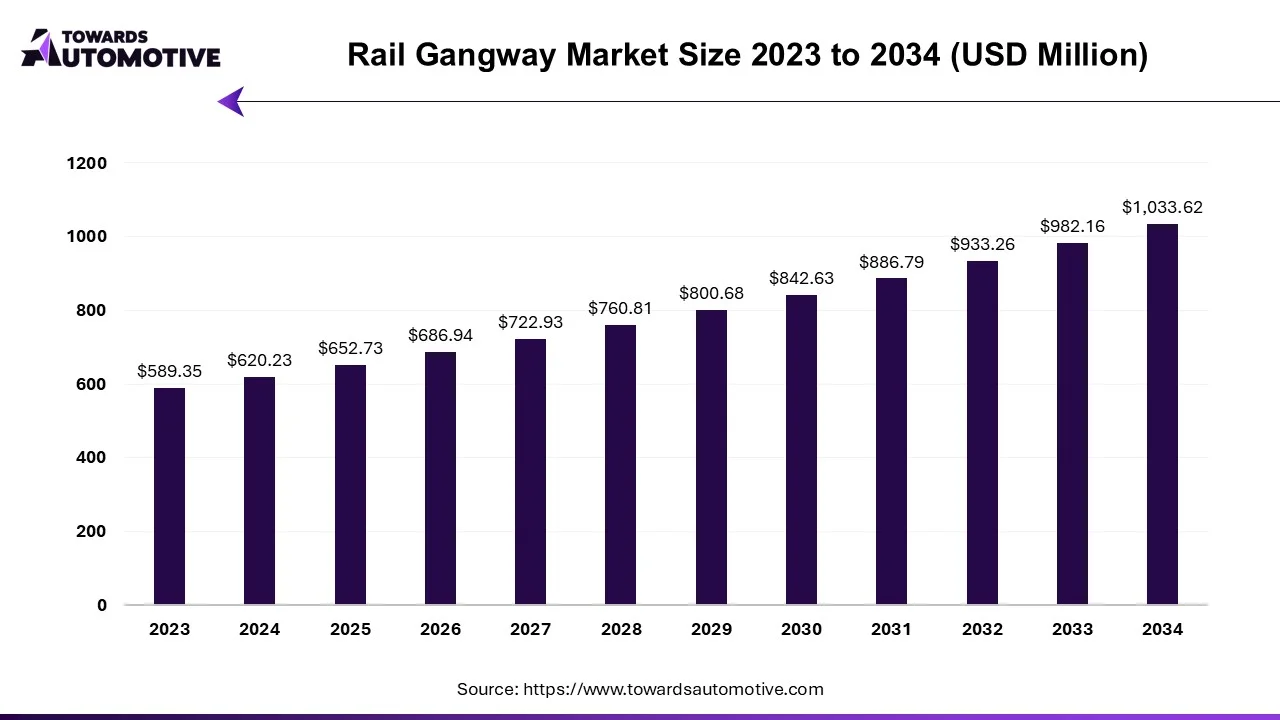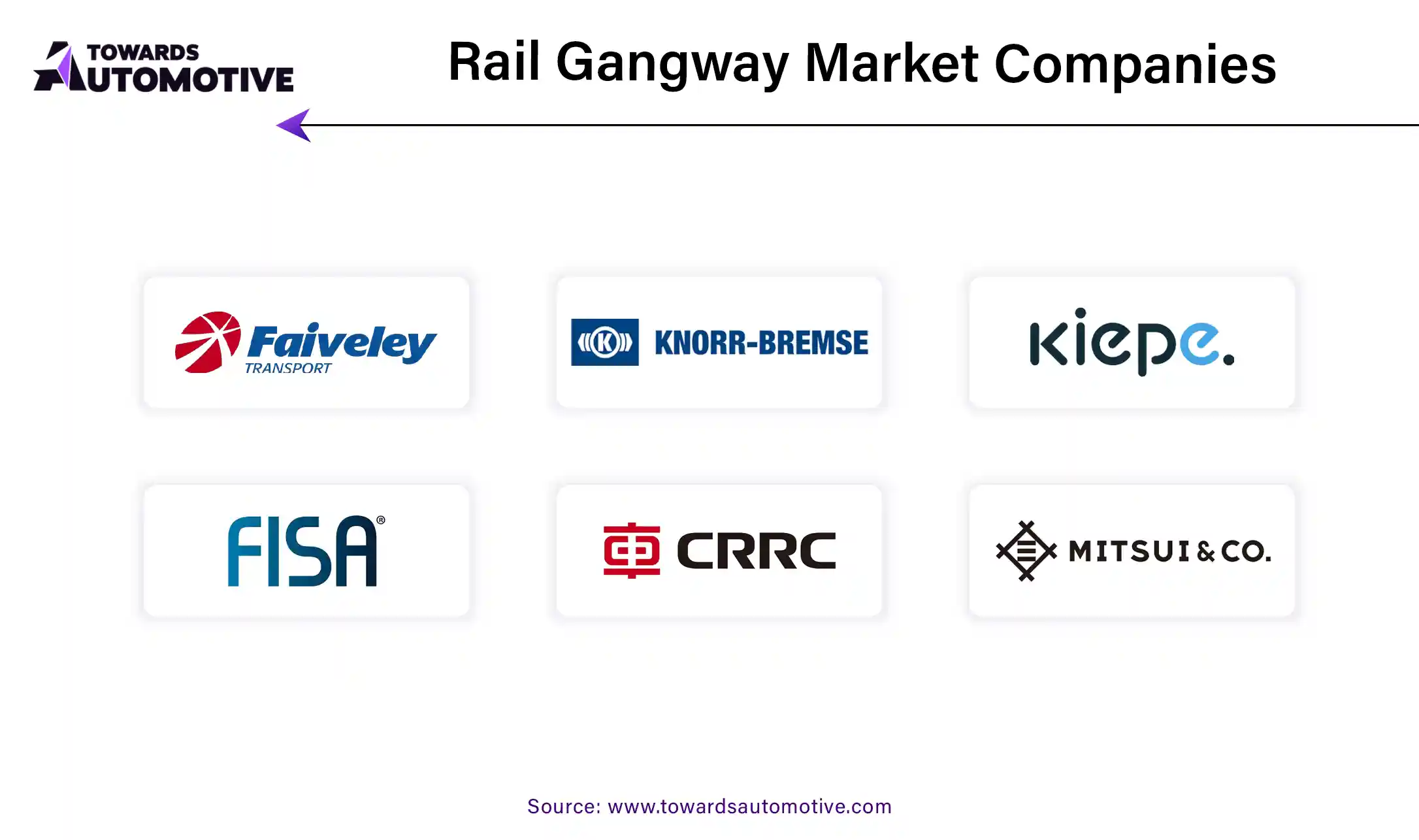Rail Gangway Market Size, Share and Competitive Landscape
The rail gangway market is projected to reach USD 1,033.62 million by 2034, growing from USD 652.73 million in 2025, at a CAGR of 5.24% during the forecast period from 2025 to 2034.

Unlock Infinite Advantages: Subscribe to Annual Membership
The rail gangway market is witnessing significant growth driven by increasing demand for safe and efficient passenger transportation solutions, technological advancements, and the expansion of rail networks worldwide. Rail gangways play a crucial role in facilitating passenger movement between rail cars, ensuring comfort, accessibility, and safety during transit. With urbanization, population growth, and the focus on sustainable mobility, the rail gangway market is poised for substantial expansion in the coming years.
Key Drivers and Trends
- Urbanization and Mass Transit: Rapid urbanization and population growth in urban centers are driving the demand for efficient mass transit solutions. Rail systems, including metros, light rail, and commuter trains, play a vital role in alleviating traffic congestion, reducing emissions, and providing reliable transportation options. Advanced gangway systems enhance passenger flow, reduce dwell times, and improve the overall efficiency of rail operations in dense urban environments.
- Accessibility and Passenger Experience: Rail operators are increasingly focusing on enhancing the accessibility and passenger experience to attract ridership and improve customer satisfaction. Gangway systems with low-floor designs, wide openings, and intuitive boarding features enable seamless boarding and disembarking for passengers of all ages and mobility levels, including wheelchair users and passengers with strollers or luggage.
- High-Speed Rail Expansion: The expansion of high-speed rail networks in regions such as Europe, Asia-Pacific, and North America is driving demand for advanced gangway solutions capable of meeting the unique requirements of high-speed train operations. Flexible gangway designs, aerodynamic profiles, and crashworthiness features ensure safety, comfort, and aerodynamic efficiency at high speeds, contributing to the growth of the rail gangway market.
- Technological Innovations: Technological advancements, including sensor-based systems, automatic door controls, and lightweight materials, are reshaping the rail gangway landscape. Smart gangway solutions equipped with real-time monitoring, predictive maintenance, and passenger information systems enhance safety, reliability, and operational efficiency, meeting the evolving needs of modern rail operators and passengers.
Market Segmentation and Application
The Rail Gangway Market can be segmented based on technology, application, and rail vehicle type
By Technology
- Manual Gangways
- Automatic Gangways
- Hybrid Gangways (Combining Manual and Automatic Features)
By Application
- Metro and Subway Systems
- Light Rail Transit (LRT)
- Commuter Trains
- High-Speed Rail
- Long-Distance Passenger Trains
By Rail Vehicle Type
- Electric Multiple Units (EMUs)
- Diesel Multiple Units (DMUs)
- High-Speed Trains
- Commuter Rail Cars
By Region
- North America
- United States
- Canada
- Mexico
- Rest of North America
- Europe
- Germany
- United Kingdom
- France
- Italy
- Rest of Europe
- Asia-Pacific
- China
- Japan
- India
- Rest of Asia-Pacific
- Latin America
- Brazil
- Rest of Latin America
- Middle East and Africa
- South Africa
- Rest of Middle East and Africa
Regional Outlook
- Europe: Europe leads the Rail Gangway Market, driven by extensive rail infrastructure, high-speed rail networks, and regulatory emphasis on passenger safety and accessibility. Countries like Germany, France, Spain, and Italy are investing in modernizing rolling stock and upgrading gangway systems to enhance passenger comfort and operational efficiency.
- Asia-Pacific: The Asia-Pacific region witnesses significant growth in the rail gangway market, fueled by urbanization, population growth, and investments in high-speed rail projects. Countries like China, Japan, South Korea, and India are expanding their rail networks and adopting advanced gangway solutions to meet the growing demand for efficient and sustainable transportation.
- North America: North America experiences steady growth in the rail gangway market, driven by investments in commuter rail, light rail transit, and intercity passenger rail projects. Rail operators in the United States and Canada prioritize passenger comfort, safety, and accessibility, driving demand for innovative gangway systems tailored to regional transit needs.

Key Players and Competitive Landscape
The Rail Gangway Market features a competitive landscape with key players focusing on product innovation, customization, and strategic partnerships.
Prominent companies operating in the rail gangway market include
- Faiveley Transport (Wabtec Corporation)
- Knorr-Bremse AG
- IFE-Venture GmbH (Voith Group)
- The Kiepe Electric Group (Knorr-Bremse AG)
- FISA Group
- CRRC Corporation Limited
- Mitsui & Co., Ltd. (Nippon Sharyo, Ltd.)
- HÜBNER Group
- Strukton Rail
- Schaltbau Holding AG
Recent Developments in the Rail Gangway Market
- In December 2023, Siemens Mobility introduced its latest generation of flexible gangway systems for trains, designed to enhance passenger comfort, accessibility, and safety. The new gangway solutions feature lightweight construction, modular designs, and advanced shock-absorbing technology, providing seamless transitions between rail cars and optimizing interior space utilization for improved passenger flow and capacity.
- In November 2023, Alstom unveiled its innovative open gangway design for metro trains, offering panoramic views, spacious interiors, and enhanced accessibility for passengers. The open gangway configuration eliminates partition walls between rail cars, creating a continuous interior space that enhances passenger comfort, facilitates movement, and reduces dwell times at stations for increased operational efficiency.
- In October 2023, CRRC Corporation Limited announced its development of next-generation gangway systems for high-speed trains, incorporating aerodynamic designs, noise-reducing materials, and advanced safety features. The new gangway solutions optimize aerodynamic performance, reduce wind resistance, and enhance passenger comfort at high speeds, contributing to improved energy efficiency and operational performance for railway operators.
- In September 2023, Bombardier Transportation launched its latest articulated double-deck trains equipped with innovative gangway systems, offering enhanced passenger amenities, onboard services, and accessibility features. The articulated gangway design allows for seamless movement between rail cars, providing passengers with a spacious and interconnected travel experience while optimizing operational flexibility and capacity management for rail operators.
- In August 2023, Hitachi Rail unveiled its cutting-edge gangway technology for commuter trains, featuring modular construction, customizable configurations, and integrated passenger information systems. The new gangway solutions enhance passenger comfort, safety, and convenience, while enabling efficient boarding and alighting processes to minimize dwell times and improve overall service reliability for urban transit networks.

